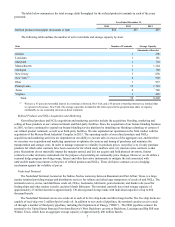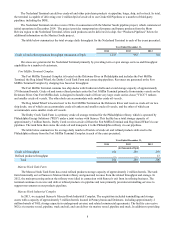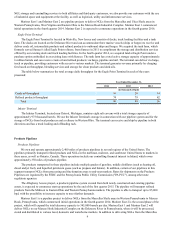Sunoco 2014 Annual Report Download - page 19
Download and view the complete annual report
Please find page 19 of the 2014 Sunoco annual report below. You can navigate through the pages in the report by either clicking on the pages listed below, or by using the keyword search tool below to find specific information within the annual report.17
ITEM 1A. RISK FACTORS
We believe that the following risk factors address the known material risks related to our business, partnership structure
and debt obligations, as well as the material tax risks to our common unitholders. If any of the following risks were to actually
occur, our business, results of operations, financial condition and cash flows, as well as any related benefits of owning our
securities, could be materially and adversely affected.
On October 5, 2012, Sunoco, Inc. ("Sunoco") was acquired by Energy Transfer Partners, L.P. ("ETP"). Prior to this
transaction, Sunoco (through its wholly-owned subsidiary Sunoco Partners LLC) served as our general partner and owned a
two percent general partner interest, all of the incentive distribution rights, and a 32.4 percent limited partner interest in the
Partnership. In connection with the acquisition, Sunoco’s interests in the general partner, including the incentive distribution
rights, and limited partnership were contributed to ETP. This resulted in a change in control of the general partner, and as a
result, we became a consolidated subsidiary of ETP on the acquisition date.
The risk factor information presented below reflects the impacts of these transactions, including the change in the general
partner ownership, and the ongoing business implications.
RISKS RELATED TO OUR BUSINESS
If we are unable to generate sufficient cash flow, our ability to pay quarterly distributions to our common unitholders at
current levels or to increase our quarterly distributions in the future, could be materially impaired.
Our ability to pay quarterly distributions depends primarily on cash flow, including cash flow from financial reserves and
credit facilities, and not solely on profitability, which is affected by non-cash items. As a result, we may pay cash distributions
during periods when we record net losses and may be unable to pay cash distributions during periods when we record net
income. Our ability to generate sufficient cash from operations is largely dependent on our ability to successfully manage our
business which may also be affected by economic, financial, competitive, and regulatory factors that are beyond our control. To
the extent we do not have adequate cash reserves, our ability to pay quarterly distributions to our common unitholders at
current levels could be materially impaired.
An increase in interest rates may cause the market price of our units to decline.
Like all equity investments, an investment in our units is subject to certain risks. In exchange for accepting these risks,
investors may expect to receive a higher rate of return than would otherwise be obtainable from lower-risk investments.
Accordingly, as interest rates rise, the ability of investors to obtain higher risk-adjusted rates of return by purchasing
government-backed debt securities may cause a corresponding decline in demand for riskier investments generally, including
yield-based equity investments such as publicly traded limited partnership interests. Reduced demand for our units resulting
from investors seeking other more favorable investment opportunities may cause the trading price of our units to decline.
A sustained decrease in demand for refined products in the markets served by our pipelines and terminals could materially
and adversely affect our results of operations, financial position, or cash flows.
The following are material factors that could lead to a sustained decrease in market demand for refined products:
• a sustained recession or other adverse economic conditions that result in lower purchases of refined petroleum
products;
• higher refined products prices due to an increase in the market price of crude oil, changes in economic conditions, or
other factors;
• higher fuel taxes or other governmental or regulatory actions that increase, directly or indirectly, the cost of gasoline or
other refined products;
• a shift by consumers to more fuel-efficient or alternative fuel vehicles or an increase in fuel economy, whether as a
result of technological advances by manufacturers, pending legislation proposing to mandate higher fuel economy, or
otherwise; and
• a temporary or permanent material increase in the price of refined products as compared to alternative sources of
refined products available to our customers.
























